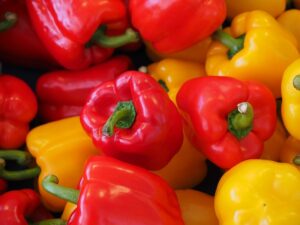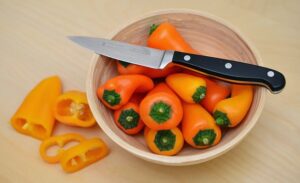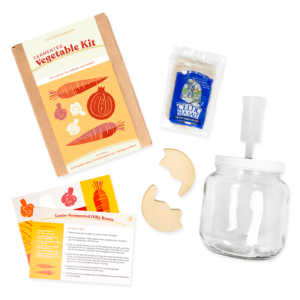How to Ferment Peppers

Gather Your Ingredients
You will need fresh peppers, sea salt, and water. Optional ingredients include garlic, onion, or spices like coriander or mustard seeds.
What supplies are needed?
- Glass jar or fermenting crock (at least 1 liter)
- Weighing scale or measuring cups
- Knife and cutting board
- Gloves (optional for handling hot peppers)
- Fermentation weights or a small, clean rock
- Cheesecloth or kitchen towel
Seeutek Fermentation Crock Jar 5 Liter / 1.3 Gallon – Stoneware Pot for Fermenting, Pickling Kimchi, Pickles, Vegetables
JILLMO Fermentation Kit, 1.5 Liter Fermentation Jar with Fermenting Weights and Airlocks, 2 Pack
Choosing the Right Peppers
The choice of peppers plays a significant role in the outcome of your fermentation. If you prefer a milder flavor, bell peppers or banana peppers are excellent choices. For a medium heat level, consider jalapenos or serrano peppers. If you’re a fan of intense spice, habanero or ghost peppers might be right up your alley. Regardless of your choice, ensure your peppers are fresh and free from blemishes or spots. Organic peppers are ideal as they’re free from pesticides which could interfere with the fermentation process. Remember, the variety of pepper not only influences the heat but also the complexity of flavor in your fermented concoction.
Can all peppers be fermented?
While most peppers can be fermented, it’s best to avoid using wax-coated or pickled peppers. These types of peppers may not produce the desired fermentation due to added preservatives and other ingredients.
Are some peppers too hot to ferment?
Yes, some peppers like the Carolina Reaper or Trinidad Scorpion are considered extremely hot and may not be suitable for fermentation. The high heat level can inhibit or alter the fermentation process, resulting in a potentially unsafe product. It’s best to stick with milder peppers for your fermented creations.
Preparing the Jars
Before you start, ensure that your glass jar or fermenting crock is clean and sterilized to prevent harmful bacteria from contaminating your peppers. You can sterilize your jar by washing it with hot soapy water and rinsing well, or by placing it in a preheated oven at 130°C (275°F) for about 15 minutes. If you’re using a fermentation weight or a clean rock, also ensure these are sterilized. Once your jar is sterilized, allow it to cool before using. This simple step can drastically improve the success of your fermenting process, ensuring that your peppers ferment safely and perfectly every time.
Prepare Your Peppers

How do you prepare the peppers?
- Wash and dry the peppers thoroughly.
- Remove the stems and seeds, if desired.
- Cut peppers into strips, slices or leave them whole.
- Wear gloves when handling hot peppers to avoid irritation.
Make the Brine
What is a brine?
A brine is a solution of water and salt that creates an environment for the beneficial
What percentage of brine is best for peppers?
A 3-6% brine is ideal for fermenting peppers. This means using 30 to 60 grams of sea salt per liter of water. (6 to 12 tsp to one quart water) The exact amount will depend on personal preference and the type of pepper being fermented.
What salt is best for fermenting peppers?
Unrefined sea salt is the best option for fermenting peppers as it contains natural minerals and helps to create a healthy environment for fermentation. It should be in fine powder form, not rock salt so your measurements will be correct.
What water is best to use?
Ideally, you should use filtered or spring water for fermenting peppers. Chlorinated tap water can potentially hinder the fermentation process and affect the taste of the final product. If using tap water, leave it in an open container for a few hours to allow the chlorine to dissipate before using it to make your brine.
Packing the Jars
How should you pack the peppers in the jar?
Start by layering your prepared peppers into the jar, adding in any desired additional ingredients such as garlic or spices. Press down firmly on the peppers to remove any air pockets and create room for the brine. Add a few layers of peppers at a time, pressing down each layer before adding more. Leave about 2-3 inches of headspace at the top of the jar.
Adding the Brine
Once the jar is packed with peppers, pour in the prepared brine until it covers the peppers completely. Use a fermentation weight or a clean rock to keep the peppers submerged in the brine and prevent mold growth.
Covering and Storing Your Jar
How should you cover your fermenting jar?
Choose a non-reactive lid for your jar, such as a plastic lid or a cloth secured with a rubber band. This will allow for the release of carbon dioxide during fermentation while keeping out debris and insects. You can also use specially-made fermentation lids for use with mason jars.
Do you need to “burb” your jars?
Yes, it is recommended to “burp” your jars during the fermentation process. This involves briefly opening the lid to release any built-up carbon dioxide and prevent pressure from building up inside the jar. This should be done once a day or every other day, depending on the level of activity in your ferment. Be sure to wash your hands before handling the lid to avoid introducing any bacteria into the jar. You won’t need to do this with fermenting lids as they allow gas to escape.
Wait for Fermentation
How long does fermentation take?
Fermentation time can vary depending on factors such as temperature and pepper variety, but it typically takes 1-2 weeks for peppers to ferment. Keep the jar in a cool, dark place and check on it regularly.
How do you know the peppers are fermented?
You will notice bubbles and a tangy smell coming from the jar, indicating that fermentation is taking place. Taste test the peppers after 1 week to see if they have reached your desired level of fermentation.
How do you know if something is wrong and you should discard it?
If you notice any mold growth or foul odors that are not related to fermentation, it is best to discard the peppers and start over. Mold growth can be harmful if consumed. Trust your senses and use caution when fermenting. It’s always better to err on the side of caution rather than risking foodborne illness. Additionally, make sure to properly clean and sanitize all equipment and jars before starting a new batch. This will help prevent any unwanted bacteria from contaminating your peppers.
Below is a link to my favorite fermenting site. It’s just for the vegetable starter as they are out of kits.
Storing Your Fermented Peppers
How do you store fermented peppers once they are done?
Transfer the fermented peppers and brine into clean jars and store in the fridge. They will continue to ferment but at a much slower rate. You can also freeze fermented peppers for long-term storage.
How long will fermented peppers last in the fridge?
Fermented peppers can last for several months in the fridge, as long as they are stored properly. Make sure to keep them submerged in the brine and check on them regularly. If you notice any mold or off smells, discard the batch.
Using your fermented peppers
How can you use fermented peppers?
Fermented peppers are a versatile ingredient that can add a tangy, spicy kick to many dishes. Blend them into sauces or salsas, chop them up and add them to salads or sandwiches, or use them as a topping for pizza or tacos. The possibilities are endless!
Do they taste different from fresh peppers?
Yes, fermented peppers will have a tangier, slightly sour taste compared to fresh peppers. They also have a softer and more complex flavor profile due to the fermentation process.
Experiment with different pepper varieties and recipes to find your favorite way to use fermented peppers in your cooking! Keep in mind that the longer you ferment the peppers, the stronger their flavor will be. And don’t forget to save some of the brine to use as a tangy addition to dressings, marinades, or drinks. This article belongs to pineyriverhomestead.com published 10-10-23
Conclusion
So even if you have finished reading this guide, don’t be afraid to continue experimenting and learning about the world of fermentation! With practice and patience, you can become a master at fermenting peppers (and other foods) and create unique and delicious dishes that your friends and family will love. Happy fermenting! So why not try your hand at fermenting peppers? It’s a simple and rewarding process that can elevate your meals to the next level. Plus, fermented foods are packed with probiotics and other beneficial nutrients, making them a healthy addition to your diet. Give it a go and see for yourself just how delicious and versatile fermented peppers can be!
Note: This content is for informational purposes only and should not be considered medical advice. As always, consult with your healthcare provider before making any changes to your diet.
For more on fermenting check out my article on how to start fermenting here.

